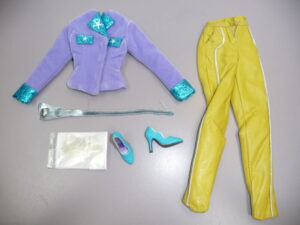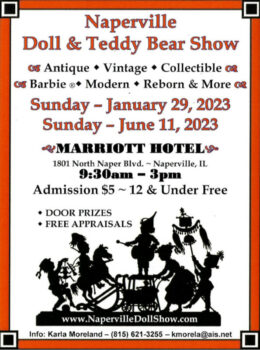 For the past 65 years, Barbie’s wardrobe has always been more than just clothing. It’s been a reflection of style, culture, and the various times she’s lived through. For collectors and fans alike, vintage Barbie clothing represents fashion in miniature and a vivid timeline of American design and social trends.
For the past 65 years, Barbie’s wardrobe has always been more than just clothing. It’s been a reflection of style, culture, and the various times she’s lived through. For collectors and fans alike, vintage Barbie clothing represents fashion in miniature and a vivid timeline of American design and social trends.
Whether you’re beginning your collection or looking to deepen your knowledge, understanding the styles, history and care of vintage Barbie fashion can bring new dimension to your appreciation of these iconic outfits. Here at Gigi’s Dolls and Sherry’s Teddy Bears, we’ve put together a guide to quickly cover all the essential information about this delightful subject.
The Timeless Appeal of Barbie’s Wardrobe
Why Vintage Barbie Clothing Still Captivates
There’s a distinct charm to vintage Barbie clothing. Each tiny zipper, satin lining, and carefully stitched hem reflects an era where doll fashion was crafted with remarkable attention to detail. These miniature garments echo the sophistication of mid-century fashion designers, offering collectors the chance to hold a piece of history in the palm of their hands.
Beyond the aesthetics, vintage Barbie clothes resonate on a personal level. Many collectors and doll lovers recall moments of their childhood, memories of dressing and redress a favorite doll, or the joy of discovering a long-lost accessory in a forgotten box. These emotional ties make collecting vintage Barbie fashion an experience that’s both personal and nostalgic.
Eras of Iconic Barbie Fashion
The 1960s – Mod, Class, and Classic Silhouettes
Barbie debuted in 1959, and her clothing almost immediately adapted to the various eras of fashion and style. Her early wardrobe quickly mirrored the elegance of postwar fashion. Sleek suits, pencil skirts, cocktail dresses, and well-fitted coats dominated the 1960s collection. These outfits, which were inspired by Dior and Chanel, featured tiny pearl necklaces, matching gloves, and coordinating handbags that brought high fashion into the doll world. As the decade progressed, Barbie’s look shifted to embrace bold prints, brighter colors, and mod influences. A-line dresses, go-go boots, and vinyl textures marked a stylish transition from sophisticated lady to fashion-forward trendsetter.
The 1970s – Disco, Denim, and New Attitudes
The 1970s introduced more relaxed and expressive looks. Barbie began to embrace individuality, with flared pants, bell sleeves, jumpsuits, and flowing fabrics appearing in her wardrobe. Denim was everywhere, often paired with metallic accents or earth-toned blouses. This disco craze made its way into Barbie’s eveningwear, with shimmering dresses and bold accessories defining her nighttime look. These outfits reflected cultural shifts, capturing the changing landscape of American identity, feminism, and pop culture
The 1980s – Big Hair, Bright Colors, and Glam
The flashy, vibrant, unapologetic 1980s Barbie wardrobe often featured sequins, puffed sleeves, neon tights, and oversized belts. Fashionistas recognize this era for its energetic color palettes and dynamic silhouettes, often influenced by television, music icons, and high fashion. But Barbie wasn’t just stylish, she was doing it all. From the business power suits to dramatic evening gowns, Barbie’s 1980’s wardrobe reflected a woman with ambition, confidence, and flair.
Beyond the 1980s – How Later Eras Carry Vintage Charm
Even the early 1990s and beyond carry nostalgic appeal for collectors today. Transitional styles, like high-waisted jeans and cropped jackets, began to replace the more exaggerated silhouettes of the previous decade. Many modern collectors now view these years as the “late vintage,” with some outfits representing the end of Barbie’s original design era before mass production shifted fashion toward simpler styles. At Gigi’s Dolls & Sherry’s Teddy Bears, we carry Barbie fashions from many of these eras, each one offering something distinct with collectors who cherish a time gone by.
How to Build a Collection That Reflects Your Style
Choosing Between Eras, Looks, and Themes
There’s no single way to collect vintage Barbie clothing. Some collectors choose to focus on a specific decade while others build thematic displays around careers, eveningwear, or everyday casual styles. Whether you prefer a tight focus or a variety of looks, each outfit adds personality to your collection and lets Barbie’s evolution shine though.
Sourcing Original vs. Reproduction Pieces
Both original vintage outfits and well-crafted reproductions play important roles in today’s collections. Reproductions allow collectors to enjoy iconic looks that might otherwise be cost-prohibitive or too fragile for display. Originals offer a direct connection to the past and are often valued for their craftsmanship and authenticity. Subtle differences in fabric, construction, and labeling can help you distinguish between the two—and learning what to look for helps protect your investment and deepen your understanding of each piece.
Displaying and Storing with Care
Vintage fabrics are sensitive to light, moisture, and time. Proper display such as using low-light cases or rotating outfits periodically can help preserve color and shape. When storing clothing, breathable materials, acid-free tissue, and labeled compartments offer peace of mind while keeping things organized. Small issues like frayed seems or loose snaps may eventually arise, especially with older garments.
Gentle handling and basic maintenance can prevent damage, but when needed, delicate repairs or fabric-friendly cleaning solutions can make a big difference. When an outfit is too delicate or valuable to trust to a do-it-yourself fix, it may be worth turning to a professional familiar with doll clothing restoration. Here at Gigi’s Dolls and Sherry’s Teddy Bears, we have a Doll Hospital that offers repair and restoration services.
Spotting Authentic Vintage Pieces
Tags, Stitching, and Labeling Clues
Original vintage Barbie garments are full of clues. Clothing tags changed in front and placement over the decades, and the types of stitching, snap closures, and linings used varied across production years. Knowing how to read these details is key to identifying true vintage. Certain outfits, especially ones that are popular or heavily reproduced, may look nearly identical to the originals at first glance. But the feel of the fabric, stitching quality, or even how accessories are constructed can reveal more than meets the eye.
Common Reproductions and What Sets Them Apart
As Barbie collecting has grown, so has the market for reproduction. Many are beautifully made and faithful to the original design. Still, they carry distinct differences—often in the sheen of the material, the rigidity of the garment, or the crispness of the stitching. Learning to spot those details take time, but it’s part of what makes collecting both a challenge and a delight.
Barbie as a Mirror of American Style
Why Her Outfits Reflect More Than Play
Barbie’s closet is more than a miniature fashion archive—it’s a record of changing times. Her early roles as a fashion model and homemaker mirrored societal norms of the 1950s and ‘60s. As decades passed, her attire began to reflect the evolving woman—career-oriented, culturally diverse, and expressive through style. Each outfit is a timestamp. From the Civil Right Era through the rise of women in the workplace, Barbie’s wardrobe tells stories that extend far beyond the playroom.
Collecting with Cultural Appreciation
Understanding the cultural context behind each outfit enhances its significance. Barbie fashion can be both a style statement and a subtle nod to the history it emerged from. Collectors often find themselves drawn to outfits that speak not only to personal nostalgia but to broader movements in art, fashion, and society.
Barbie’s clothing offers more than just charm—it invites us to reflect on how far we’ve come, and how fashion continues to express who we are. That’s why Gigi’s Dolls and Sherry’s Teddy Bears sells vintage Barbie dolls and clothing from just about every era. Contact us today to learn more about the incredibly vast collection of dolls, dollhouse miniatures, and doll accessories we have in stock.


